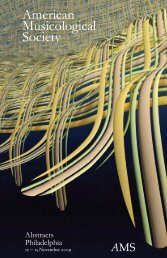Abstracts - American Musicological Society
Abstracts - American Musicological Society
Abstracts - American Musicological Society
Create successful ePaper yourself
Turn your PDF publications into a flip-book with our unique Google optimized e-Paper software.
t2<br />
ThursdaY afternoon<br />
concerns in his compositional decisions, and 3) his<br />
increasing sensitivity to text expression.<br />
THE KECKE BESERL AND BRUCKNER'S SYMPHONIC SYNTHESIS<br />
Stephen Parkany, Amherst College<br />
In the early 1850s, while still in provincial<br />
Linz, Bruckner fe11 in with a tiny coterie of rnusicians<br />
there who embraced the avant-garde scores of Tristan<br />
und Isolde and the Faust Syrnphony. (His previous,<br />
better-known studies !{ith Simon Sechter and Otto<br />
Kitzler had been remarkable more for sr{reat than for<br />
distinctive inspiration. ) These new enthusiasms led<br />
directly to the extraordinary formal innovations of his<br />
Habilitationsschrift, rhe Synphony No. 1 of 'J-865-66 .<br />
Relishing its boldness, Bruckner nicknamed the symphony<br />
das kecke Beserl , or loosely, " the fresh kid. "<br />
I evaluate the progressive emphasis upon the<br />
dynarnic concept of ',intensification" (Steigerung) in<br />
the influential text Kitzler assigned Bruckner, E. F.<br />
Richter's Grundziige der rnusikalischen Form (1g52), and<br />
apply the concepc to the neglected Symphony No. 1, in<br />
which Bruckner first synthesized such progressive<br />
formal techniques with traditional schemata. If we can<br />
credit his later claim that this r,rork r{ras still his<br />
rrmost difficult and best," this must be due to irs<br />
Tristan- 1ike mastery of extensive linear bass<br />
prolongations and of motivic developing variation,<br />
growing (as in Tristan and the Faust Synphony) from a<br />
single dissonant kernel. The complex yet cogently<br />
expressive formal process that results renders the<br />
kecke Beserl a landmark in what otherwise were the<br />
symphonic doldrums of the l86Os.<br />
RESPONDENT: Paul Hawksharrr, yale University<br />
TOWARD AN UNDERSTANDING OF BRUCKNER'S REVISIONS<br />
Mariana Sonntag, University of Chicago<br />
Notwithstanding all the attention accorded the<br />
revisions of Bruckner's symphonies, we are no closer to<br />
a musical understanding of how they were made or why<br />
(except in instances vhere he alleviated unwieldy or<br />
especially long mowements) How did Bruckner<br />
"o^L<br />
to<br />
make these specific alterations and why these specific<br />
passages? The revisions do not reveal rnuch<br />
Bruckner,s approach to the synphony b.;;"";*;;^,:o:"' ";:,<br />
post-compositional- -nade after Bruckner h",t<br />
".^'l .:.<br />
intents and purposes , finlshed the oi""-*",^--ror _al1<br />
after it had already been -<br />
p.rform.i -'' drrQ<br />
L<br />
otten<br />
Fassungen thus leave us u,{rL<br />
rrre various<br />
producrs- -essentiatly, "before" ";;il"t."tt,o or"lillif"o










